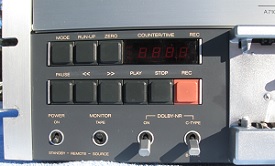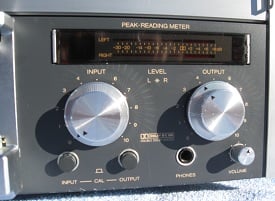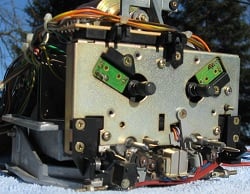Vintage Audio: Studer A710 Cassette Deck | Telos Alliance
By The Telos Alliance Team on Mar 25, 2014 11:25:00 AM
 Vintage Audio: Studer A710 Cassette Deck
Vintage Audio: Studer A710 Cassette Deck
When precision, Swiss engineering is applied to a cassette recorder, the results are spectacular. Some of the best examples of this were the professional cassette recorders manufactured by Studer Revox.
Lurking in the recesses of the attic recently we found not one, but two Studer A710 MKIIs. We'll examine this machine, and tear down the transport to see what made it so exceptional.
The audio cassette tape underwent an incredible revolution over its lifespan. Invented in 1963 by Phillips, the cassette was originally intended for office dictation machines and voice grade recording. Over the next twenty or so years, refinements were made. Tape shells were made to precision specifications. Metal, ferric and chrome high-bias tapes were developed. Thinner tapes were developed, enabling 1 hour of recording per side. Transports were designed to precision specifications, and high-quality electronics with integrated circuits became available. Then there were Dolby B and C noise reduction schemes. In later years, machines were introduced with auto reverse and high-speed dubbing.
By the early ‘80s, the sound quality of the medium was close to that of reel-to-reel machines. Seeing a new market for cassettes in small recording studios and broadcast, some manufacturers began to produce professional-grade rack-mount machines with high-end specs and balanced inputs and outputs.
Arguably the ultimate professional cassette decks were manufactured by Studer Revox, with the A710 MkII a prime example. The transport chassis of the 710 is cast metal to ensure maximum stability. The parts that usually wear out have been virtually eliminated. There are no belts, friction wheels, slip clutches or mechanical brakes. Pinch rollers are the only parts that are regularly replaced on the B710 transport. Heads are designed for extremely long life.
Instead, the shockmounted transport features two DC spooling motors and two direct drive motors which are controlled individually by a common quartz oscillator. The headblock engages the tape via an air damped solenoid. All of this contributes to wow and flutter specs of 0.1%.
The A710MKII also achieved a frequency response of 20–20,000 Hz and a dynamic range of over 72 dB with Dolby C on chrome and slightly less dynamic range, but greater headroom with metal tapes and Dolby C. Revox actually adjusted the frequency range on delivery with many years of use in mind: when new, the frequency curve went upwards a few dB at 15–20 Khz, aiming for flat response after 15 years of use, and headwear to match. When it was introduced in 1981, the A710 had an MSRP of $2,200.
That princely sum bought a lot of cool features. The tape counter was also a clock/timer, so the machine could be set up to record programs and start other equipment. A memory function allowed users to store start and stop locations, and have machines play these segments repeatedly.
Cassettes which were coded according to IEC standards (all those slots on top of the cassette) could be automatically detected, so no worries about setting the wrong bias. When cassettes had a clear leader, the 710 would automatically cue to the beginning of the tape and stop.
Construction of the A710 is what you'd expect from Studer, and very similar to that of its reel-to-reel machines. Circuitry is sub-divided into removable modules, and it's quick work to tear the machine down to circuit boards, mother boards, cosmetic parts and transport. All tweaks are easily reached without contortions.
 The only weak spot on these machines is the pin-style edge connectors on circuit boards, a trait common to all Studer/Revox products. They are easily bent, and straightening them out again can be tedious and time consuming. Best practice is to keep small blocks of hard styrofoam on hand, and stab them on the connectors the moment they're removed from the machine. These circuit boards are difficult to properly insert back in the mother board even when all of the pins ARE straight.
The only weak spot on these machines is the pin-style edge connectors on circuit boards, a trait common to all Studer/Revox products. They are easily bent, and straightening them out again can be tedious and time consuming. Best practice is to keep small blocks of hard styrofoam on hand, and stab them on the connectors the moment they're removed from the machine. These circuit boards are difficult to properly insert back in the mother board even when all of the pins ARE straight.
The generation of cassette machines which followed the A710 went even further, with dynamic tweaking of bias and equalization during recording. Broadcasters remember Revox for their A77, B77 and PR99 reel-to-reel machines. But the company also produced the B740 power amp, a high-end FM tuner, the B739, and a turntable, the B795, with an innovative parallel-arm design. Shortly after Studer released these products, the company got into financial troubles. A decision was made to close out the Revox brand, along with all of its consumer products.
This pair of A710s came from a dumpster diving expedition that also yielded service manuals and a box of spare parts. Both work and sound great. They're awaiting replacement electrolytic capacitors and complete realignment. Perhaps once they're tuned up, and with 20 years of use behind them, the response will be ruler flat from 20 Hz to 20 Khz.
Telos Alliance has led the audio industry’s innovation in Broadcast Audio, Digital Mixing & Mastering, Audio Processors & Compression, Broadcast Mixing Consoles, Audio Interfaces, AoIP & VoIP for over three decades. The Telos Alliance family of products include Telos® Systems, Omnia® Audio, Axia® Audio, Linear Acoustic®, 25-Seven® Systems, Minnetonka™ Audio and Jünger Audio. Covering all ranges of Audio Applications for Radio & Television from Telos Infinity IP Intercom Systems, Jünger Audio AIXpressor Audio Processor, Omnia 11 Radio Processors, Axia Networked Quasar Broadcast Mixing Consoles and Linear Acoustic AMS Audio Quality Loudness Monitoring and 25-Seven TVC-15 Watermark Analyzer & Monitor. Telos Alliance offers audio solutions for any and every Radio, Television, Live Events, Podcast & Live Streaming Studio With Telos Alliance “Broadcast Without Limits.”
Recent Posts
Subscribe
If you love broadcast audio, you'll love Telos Alliance's newsletter. Get it delivered to your inbox by subscribing below!